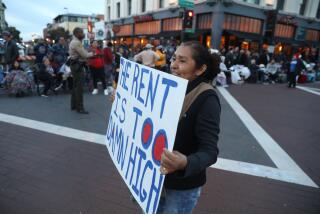
- Share via
The movie “The Big Short” — dramatizing the reckless behavior in the banking and mortgage industries that contributed to the 2008 financial crisis — captures much of Wall Street’s misconduct but overlooks a central player in the collapse: the federal government, specifically through Fannie Mae and Freddie Mac.
These two government-created and government-sponsored enterprises encouraged lenders to issue risky home loans by effectively making taxpayers co-sign the mortgages. This setup incentivized dangerous lending practices that inflated the housing bubble, eventually leading to catastrophic economic consequences.
Another critical but overlooked factor in the collapse was the Community Reinvestment Act. This federal law was intended to combat discriminatory lending practices but instead created substantial market distortions by pressuring banks to extend loans to borrowers who might otherwise have been deemed too risky. Under threat of regulatory penalties, banks significantly loosened lending standards — again, inflating the housing bubble.
After the bubble inevitably burst, Fannie and Freddie were placed under conservatorship by the Federal Housing Finance Agency. The conservatorship imposed rules aimed at preventing future taxpayer-funded bailouts and protecting the economy from government-fueled market distortions.
Now, President Trump’s appointee to lead that agency, Bill Pulte, is considering ending this conservatorship without addressing the core structural flaw that fueled the problem in the first place: implicit government guarantees backing all Fannie and Freddie mortgages. If Pulte proceeds without implementing real reform, taxpayers on Main Street are once again likely to be exposed to significant financial risks as they are conscripted into subsidizing lucrative deals for Wall Street.
Without genuine reform, the incentives and practices that led to the crisis remain unchanged, setting the stage for a repeat disaster.
Pulte’s proposal isn’t likely to unleash free-market policies. Instead, it could further rig the market in favor of hedge funds holding substantial stakes in Fannie and Freddie, allowing them to profit enormously from the potential upside, while leaving taxpayers to bear all the downside risks.
A meaningful solution requires Fannie and Freddie to significantly strengthen their capital reserves. The two government-sponsored enterprises still remain dangerously undercapitalized. A report from JP Morgan Chase describes it this way: “Despite steady growth in [their net worth], the GSEs remain well below the minimum regulatory capital framework requirements set by the Federal Housing Finance Agency in 2020.” Imposing robust capital requirements similar to those that govern private banks would oblige the two enterprises to internalize their risks, promoting genuine market discipline and accountability.
Further reforms should address transparency and oversight. Enhanced disclosure standards would allow investors, regulators and the public to better assess risks. Additionally, limiting the types of mortgages these entities can guarantee could reduce exposure to the riskiest loans, further protecting taxpayers. Implementing clear rules that prevent Fannie and Freddie from venturing into speculative financial products would also mitigate potential market distortions.
Critically, the federal government must clearly communicate that future bailouts are not an option. Explicitly removing government guarantees would compel Fannie and Freddie to operate responsibly, knowing that reckless behavior will lead to their insolvency, not to another taxpayer rescue. Clear legal separation from government backing is essential to prevent moral hazard.
The combination of government guarantees, regulatory pressure from policies such as the Community Reinvestment Act and inadequate capital standards created the perfect storm for the 2008 financial crisis. Ignoring these lessons and repeating past mistakes would inevitably lead to a similar disaster.
Proponents of prematurely releasing Fannie and Freddie argue that market conditions have changed and risk management has improved. Yet, history repeatedly demonstrates that without structural changes, financial entities — particularly those shielded by government guarantees — inevitably revert to risky behavior when market pressures and profit incentives align. Markets function best when participants bear the full consequences of their decisions, something impossible under the current structure of these government-sponsored enterprises.
Ultimately, the only responsible approach is removing taxpayers from the equation entirely. Fannie Mae and Freddie Mac should participate in the mortgage market only as fully private entities, without any implicit government guarantees.
The American public doesn’t need a sequel to “The Big Short.” The painful lessons of the 2008 crisis are too recent and too severe to be ignored or forgotten. Market discipline, fiscal responsibility and genuine reform — not government-backed risk-taking — must guide our approach going forward. We can only hope that the Trump administration chooses fiscal responsibility over risky experiments that history has already shown end in disaster.
Veronique de Rugy is a senior research fellow at the Mercatus Center at George Mason University. This article was produced in collaboration with Creators Syndicate.
More to Read
Insights
L.A. Times Insights delivers AI-generated analysis on Voices content to offer all points of view. Insights does not appear on any news articles.
Viewpoint
Perspectives
The following AI-generated content is powered by Perplexity. The Los Angeles Times editorial staff does not create or edit the content.
Ideas expressed in the piece
- The article argues that government policies, particularly through Fannie Mae and Freddie Mac, played a central role in the 2008 financial crisis by incentivizing risky lending practices through implicit taxpayer guarantees[1][3].
- It claims the Community Reinvestment Act distorted markets by pressuring banks to extend loans to high-risk borrowers, further inflating the housing bubble[4].
- The author criticizes proposals to end the FHFA conservatorship of Fannie and Freddie without structural reforms, warning that implicit government guarantees remain intact, exposing taxpayers to future bailouts[2][3].
- Recommendations include privatizing Fannie and Freddie entirely, eliminating government backing, imposing stricter capital requirements akin to private banks, and banning speculative financial products to prevent market distortions[1][4].
Different views on the topic
- Critics assert
A cure for the common opinion
Get thought-provoking perspectives with our weekly newsletter.
You may occasionally receive promotional content from the Los Angeles Times.









